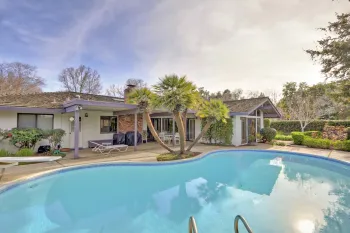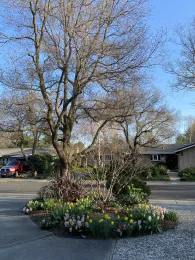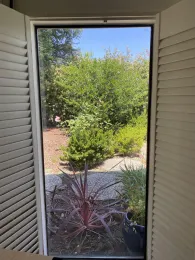Article by Kate Bear -

Nearly three years ago, my husband and I moved to Davis. The house we bought for our retirement life had a yard that included drip irrigation and no lawn, two positive attributes. The landscape was neat and easy to maintain, but didn’t satisfy my desire for variety, color, and complexity. I wanted to encourage more beneficial insects, bees, and birds, and create more layers (very low growing plants to taller plants). Most of the shrubs were pruned into balls or hedges and didn’t flower. There was a lot of space between plants with bark mulch, which I wanted to plant.
This article will be the first of three articles addressing different aspects of transitioning the yard to one that better meets my desires. This work is ongoing as ideas occur to me. Following is a discussion about keeping, enhancing, and creating focal points.
We inherited two excellent focal areas with this yard. One is a group of four palms planted by the pool in the back yard. The other is an area in the center of the front yard where a crape myrtle bush and late-winter flowering bulbs grow under a city tree and easily viewed from both the street and the house. We created a third focal point in the back yard that can be seen when sitting in the living room or on the back patio.

The focal area by the pool contains four Mediterranean fan palms (Chamaerops humilis) that grow in a cluster and create a vacation oasis in our own backyard. These palms do well in our region and require very little care, periodically needing some dead fronds (leaves) removed. They seem to be doing well with sufficient moisture through annual rainfall and very little supplemental irrigation. This palm, as with most palms, needs a fertilizer intended for palms, rather than a general fertilizer. Palms need magnesium and potassium in amounts that are greater than what is found in a regular fertilizer. They also may need one or more micronutrients, and fertilizers formulated for palms will contain these. The Mediterranean fan palms really add to the attractiveness of the pool area in the backyard providing interest, shade, and greenery in a paved patio.

In the center of the front yard, a variety of bulbs grow under a large crape myrtle bush (Lagerstroemia sp.) and a city tree (Chinese tallow, Sapium sebiferum). The bulbs provide pink, yellow, and white color when the tree and shrub are still leafless in February. They include daffodils, narcissus (Narcissus sp.), tulips (Tulipa sp.) and hyacinths (Hyacinthus orientalis). In midsummer, when the tree has leafed out and the bulbs are spent, the crape myrtle provides spectacular color, covered with magenta flowers. The bulbs get sufficient water with winter rains to bloom beautifully. There is drip irrigation installed for summer watering of the tree and other plants growing under it. Other options for a tree that would do well under a large tree and needs less sunlight (understory tree) include redbud (Cercis occidentalis) or California buckeye (Aesculus Californica), both of which are native to California and require less water to grow well. A nonnative understory tree that would do well is Japanese maple (Acer palmatum).

In the backyard, a crape myrtle grows against the back fence and can be seen through a wall of glass created by the floor-to-ceiling windows and a sliding glass door on one wall of the room. When we moved in, a pittosporum (Pittosporum tobira) and a heavenly bamboo (Nandina domestica) grew right up against the windows, partly blocking the view. Beyond these shrubs grows a boxwood hedge (Buxus sp.) and long-stemmed, pink rose plants. The roses are beautiful and bloom earlier in the year than the crape myrtle. When we realized how spectacular the crape myrtle was when it bloomed, we wanted to create a focal point emphasizing it in the summer and adding some interest with the other plants in front of it. The shrubs growing against the window were removed and replaced with three Hawaiian Ti plants (Cordyline fruticosa). These have pink to dark reddish purple strap-shaped leaves and add an accent without blocking the view. A few of the rose plants were crowded and required removal or relocation to another part of the yard. A couple of the boxwood plants also needed removal to open up the area around the roses and crape myrtle. Now the crape myrtle has more room to flourish, and with minimal changes we were able to create a new focal point.
Future articles will talk about how we rehabilitated several areas of the yard, increased color and complexity, and attracted more pollinators and beneficial insects by planting low-water use plants.
All photos by Kate Bear.

